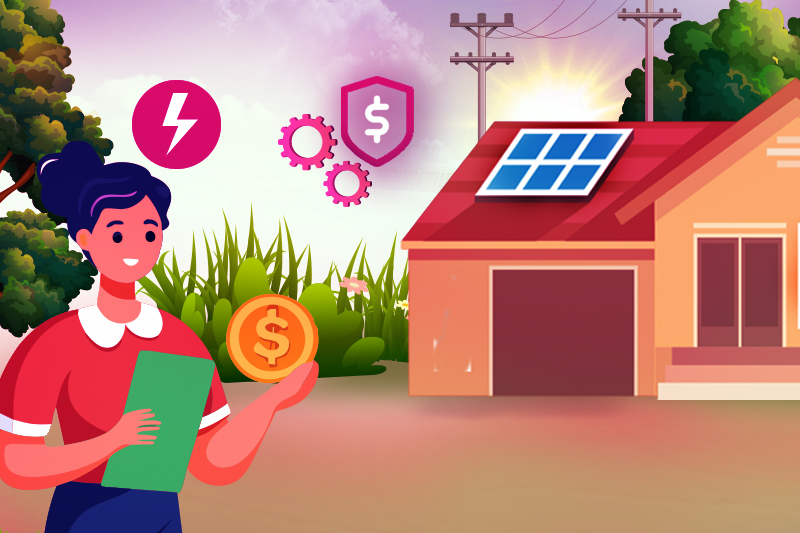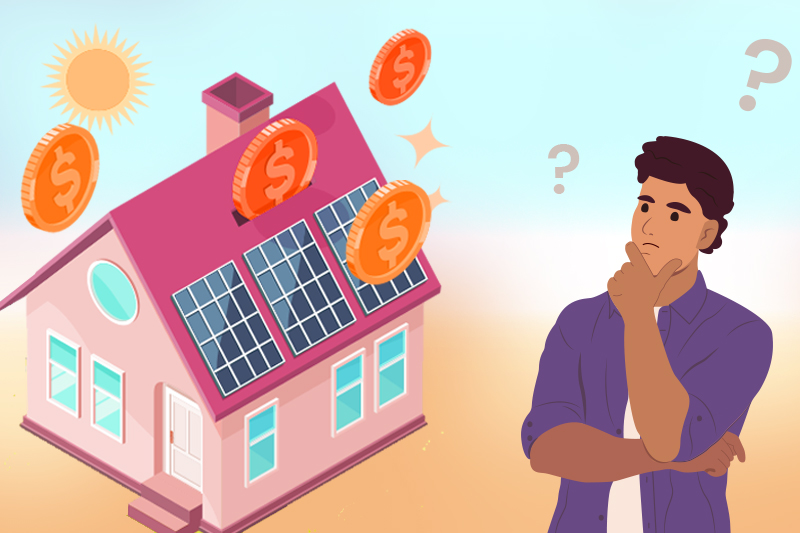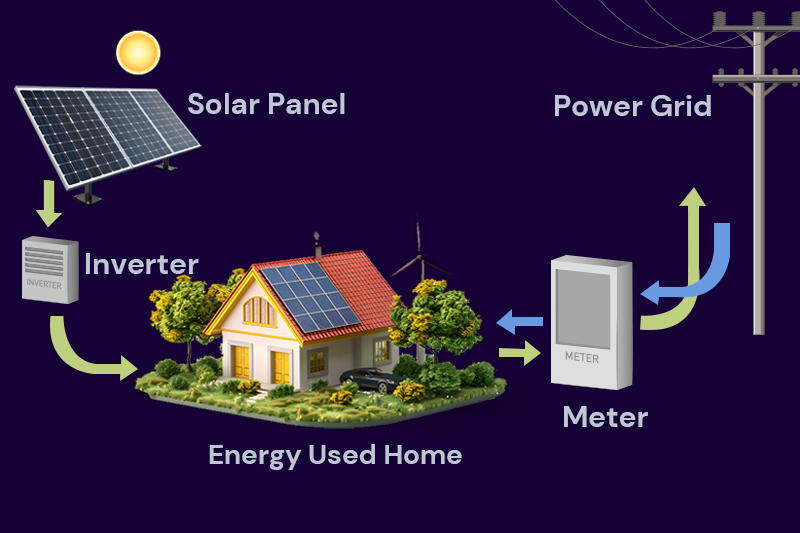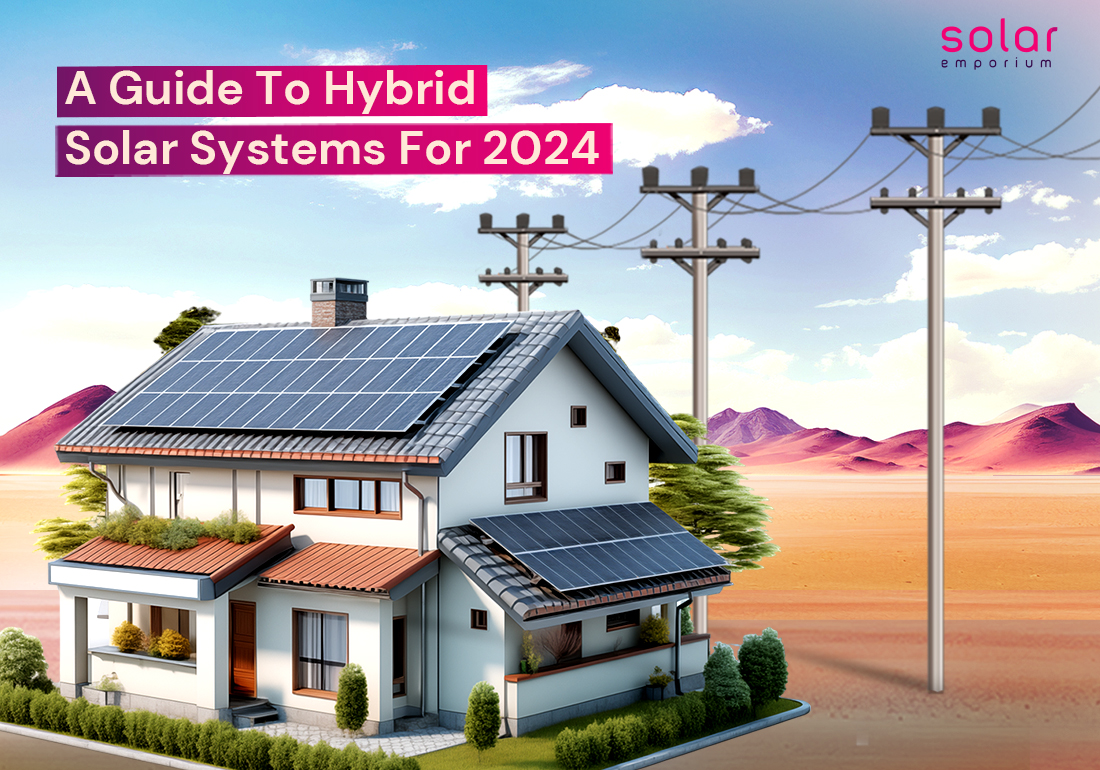A hybrid solar system can operate both on and off-grid solar systems. Under normal circumstances, a solar photovoltaic (PV) system is linked to your utility grid, allowing you to use both power sources simultaneously.
However, a hybrid solar panel system can also function independently, providing power during blackouts. For more information, here is a guide to hybrid solar systems for 2024.
More people seek ways to become more self-sufficient and promote a more environmentally friendly planet, and solar energy sources have emerged as a top solution.
Hybrid solar systems are a fantastic innovation that allows homeowners to harness free energy generated by the sun and use it to supplement their home’s electricity needs throughout the year.
What is A Hybrid Solar System?
A hybrid solar system connects to both the electricity grid and a battery for solar storage. Like regular home solar setups, solar panels on your roof or the ground turn sunlight into electricity that runs your home. Any extra energy goes into the grid or a battery pack for later.
When you’re connected to the grid, you rely only on traditional solar power systems. Solar panels alone can’t always give a steady power supply for home appliances.
For instance, if a cloud covers the sun or during nighttime when there’s no sunlight, the power generation drops. At these times, you depend on grid energy to fill in the gaps.
Hybrid solar systems have a battery system that provides energy even when your panels are not connected to the grid. If your solar panels produce less electricity because of clouds, a charged solar battery can keep a steady voltage and power output.
This means hybrid PV systems can work with the local electricity grid but don’t need it all the time.
How Does a Hybrid Solar System Work?
Here are the components of a hybrid solar system:
Solar Batteries: A solar battery (usually lead acid or lithium-ion) stores extra energy for later use.
Charge controller: This device protects batteries from getting too much charge, which can make them wear out faster.
Hybrid inverter: This inverter turns the solar cells’ direct current into alternating current. It also controls the power from the panels and battery and connects with the grid.
Metering/monitoring system: Hybrid solar systems have a system that tracks how much energy is made and used. It checks efficiency and helps manage energy.
Solar panels: Each panel has lots of solar cells that capture sunlight and make electricity.
Switchboard: These send electricity to your appliances.
Hybrid systems blend grid-connected and off-grid features. They keep power going by switching between solar, battery, and grid electricity when needed.
So, you’ll have electricity even during grid problems or cloudy days. They also reduce reliance on the grid, letting you use stored power during expensive peak times or emergencies.
Normally, regular solar systems require the grid to work. Solar panels alone can’t always give a steady power supply for home things like appliances.
For example, if a cloud covers the sun, the power from the panels drops. At night, with no sun, there’s no power. At these times, you rely on energy from the grid.
Hybrid solar systems use batteries to give power even when the panels aren’t linked to the grid.
If it’s cloudy and the panels produce less electricity, a charged solar battery can keep a steady power supply. This means hybrid systems can use the grid but don’t need it all the time.
The panels gather sunlight and convert it into direct current (DC) electricity. Since most home devices use alternating current (AC), a solar inverter changes the DC to AC electricity. The AC electricity then goes to the switchboard, which decides how to use it.
The switchboard sends electricity to your appliances, stores it in solar batteries, or sends it back to the grid to earn money.
How Much Do Hybrid Solar Systems Cost?

The average cost of a hybrid solar system ranges from $15,000 to $35,000. However, the actual cost can vary based on factors like your chosen installer, equipment, number of solar batteries, and location.
Typically, solar panel systems without battery storage are priced between $15,000 and $20,000. Adding a battery can increase the total cost by around $10,000 or more.
For instance, the Tesla Powerwall costs $11,500 including installation. With one battery, the total system cost might range from $26,500 to $31,500.
If you have higher energy needs, you might require multiple batteries, which would further increase the cost.
You can reduce the cost of your solar system by taking advantage of incentives such as the federal solar tax credit and state rebates.
Advantages of Hybrid Solar Systems
A hybrid solar system offers flexibility by combining features of grid-tied and off-grid systems in one setup.
Here are some benefits:
Increased Savings on Electricity Bills:
- With standalone solar panels, you can only use generated electricity during the day unless you have a battery or rely on the grid. A hybrid solar system can provide electricity 24/7, covering your energy needs day and night. The solar array can be sized to meet your daytime usage and generate extra energy stored in a battery for later use.
- Many states offer net metering programs where you can send excess power to the grid for credits. A hybrid system saves the full value of each unit of electricity, unlike standard solar systems that may get partial credit.
Backup Power During Outages:
- A hybrid solar system with energy storage can supply backup power during blackouts, unlike grid-tied systems that can’t stabilize voltage without the grid.
- Even in areas with rare outages, a hybrid system provides energy independence. For instance, if you have high electricity prices during peak hours (time-of-use tariff), you can rely on your system instead of the grid during those times.
Qualify for More Financial Incentives:
- Traditional solar panel systems qualify for solar incentives, but hybrid systems also benefit from energy storage incentives.
- Installing a hybrid solar system makes you eligible for a higher federal solar tax credit, covering 30% of solar and battery costs against your federal taxes.
- In places with less favorable net metering policies, like Victoria and NSW, where grid-tied solar credits are reduced, a hybrid system can save more by storing energy for later use instead of exporting it to the grid.
Hybrid Systems vs. Grid-Tied Systems vs. Off-Grid Systems
Homeowners have three main choices when it comes to solar power systems:
Grid-Tied Solar System:
Grid-tied systems use a solar inverter that links directly to the utility grid. Any extra energy produced by the solar panels goes back to the grid. If your goal is mainly to reduce energy costs, this is the most affordable option.
Off-Grid Solar System:
Off-grid systems are completely self-sufficient. They store extra solar energy in batteries for later use when there isn’t enough sunlight. These systems are necessary in remote areas but are more expensive than grid-tied or hybrid systems.

Hybrid systems are very popular because they offer a good balance between on-grid and off-grid setups.
Traditional on-grid solar systems use solar energy to power your home, but they don’t store energy in batteries. This means you still rely on the main electricity grid when there’s no sunlight, like at night or on cloudy days.
Off-grid systems are more expensive and require large battery storage to run your home independently of the grid 24/7.
A hybrid energy system is a middle ground that combines both. It includes battery storage to save solar energy for times when solar power isn’t available. What’s great is that a hybrid system remains connected to the public grid.
This means you can use grid electricity when your battery is low or when there’s no solar power, like at night.
What Makes Hybrid Solar Panels Different?
The way hybrid solar panels and off-grid solar systems work is quite similar. Both use “Photovoltaic cells” to turn sunlight into DC power. This power can be stored in batteries or converted to AC power by a solar inverter.
When you have surplus electricity from your hybrid solar panels, you have two choices: store it for later or send it back to the grid.
Hybrid solar panels and off-grid systems have different advantages. The decision between them depends on your specific needs and preferences.
Hybrid Solar Panels:
Hybrid solar panels offer the benefit of being connected to the electrical grid. This means that when your solar panels can’t produce enough power, like on cloudy days or when there’s high energy demand, you can still use the grid for electricity. This gives you flexibility and ensures a steady power supply. If your hybrid system produces extra energy, you can send it back to the grid and potentially get credits or payment for it.
Off-Grid System:
On the other hand, an off-grid system provides complete energy independence by relying solely on solar power. This eliminates the risk of changing utility costs and gives you resilience during power outages.
Off-grid solar systems are environmentally friendly and can reduce your carbon footprint since they use only renewable energy. However, it’s important to know that off-grid systems aren’t always reliable.
During long periods with little sunlight or when your system needs maintenance, there’s no backup power source available for your off-grid solar system.
Are Hybrid Solar Panels Reliable?

A hybrid PV system allows you to use less grid electricity while maintaining access to the grid station. High-efficiency panels will increase your energy production. The ability of hybrid solar panels to provide a continuous supply of electricity during inclement weather or power outages is what distinguishes them.
Hybrid solar power systems also allow you to sell excess energy to grid companies in exchange for bill credits, potentially lowering your electricity bill. If you want to go completely off-grid, you cannot sell any excess electricity to utility companies.
Overall, hybrid solar panel systems are more stable and reliable than off-grid solar arrays.
The decision to purchase a hybrid solar system is based on a variety of factors. These factors include the local grid’s reliability, the availability of sunlight in your area, your energy consumption habits, and your desire for energy independence.
Assessing your household energy requirements and consulting with solar energy professionals can help you choose the best option for your needs.







